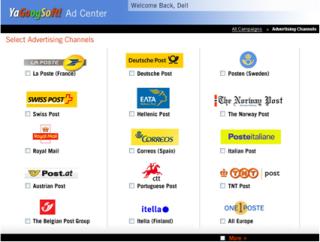
What Can Posts Have That Google Never Will? Billions of Users of Reverse Hybrid Direct Mail
Cameron Powell, Earth Class Mail Corporation.
World Mail Review November 2008 The ‘Google’ Model
People are always talking about Google. The talking heads say that Google – search, local, print, and wireless all in one – is the future of advertising. (More breaking news: the Google phone, “G1”, was just released to capture searches for and present advertising. Now back to our story).
What they really mean, of course, is not Google per se but the new model Google. (Students of business know that like any father great or small, Google will eventually be overtaken or even eaten by its offspring.) The connected advertising model is growing at over 20% year after year, whilst mail volume is shrinking. Is this why these smart people aren’t also talking about the posts’ technology future?
What’s disturbing is that the posts aren’t talking about the posts either. Can it really be that they are too close to what they have, or too focused on what they have been doing, to see what they alone could do in the near future?
Many posts seem shy on the subject of “Google’s” model, the Internet, search engines, and connected advertising. Maybe they think, “We just don’t understand this stuff. We could never do what they do.” On at least the second point, they would be wrong.
Posts have a very bright future in messaging and e-commerce because posts have advantages that Google, Microsoft, and Yahoo do not now and never will. Posts have (1) billions of (2) everyday (3) customers (also known as users, visitors, ‘eyeballs’) who are (4) in great pain, in business terms. Think about this: posts no longer have the most commercial transactions of any industry on earth but still directly address the most consumers of any communication-related industry on earth. What better blueprint for the disruptive change that attracts venture capital to start ups with a killer app, and private equity to posts with an idea?
Students of the first dot-com era, pre-spring 2000, may recall the term eyeballs with a shudder. So many business models were designed to get eyeballs without the foggiest notion of what to do with them, how to make them want to come back, or how to get them to buy something. “We’ll get them to come to the site and then we’ll hit them with advertising banners! It’ll be brilliant!”
It’s not bad to say eyeballs, just as it’s not bad to say “dot-post.” But in both cases you have to make sure the eyeballs are attached to consumers who repeatedly require your solution to solve some real pain. Or they will never come back. Eyeballs without a killer app equals disaster.
So maybe posts do not talk about having more consumers among them than any communication-centric industry on the planet because they haven’t yet stumbled on the killer app that would make it matter.
The Models They are a Changin’
What if the killer app could be seized now and posts (for once!) had an unfair advantage? Will the posts see it soon enough? As always happens, someone, either from within the postal industry or, fatally, from outside it, is going to be the first to see the cultural trends and decide to act.
Disruptive business ideas do not exist in the collective sub-consciousness like Jungian archetypes awaiting discovery. Rather, visionary companies invent them. “How did they know that would happen?” people ask. Well, they didn’t know, at first. But they did believe in their interpretation of human behavior and cultural trends. Then, in the spirit of the scientific method, they tested their belief. Feedback! Eureka! It works!
So without further ado, here are ten beliefs, all pertaining to mail, that I have seen to work, and that together add up to facts ignored at the postal industry’s peril. Let’s call them —
Ten Factual Reasons Why It Would Be a Tragedy for Posts to Ignore Reverse Hybrid Direct Mail Online
- Businesses want to save lots of money in direct costs.
- Businesses want to increase employee productivity, creating more value per hour of work.
- Businesses and their customers want to reduce external costs, such as carbon-based emissions in the air and pollutants in the water.
- Businesses and their customers want to reduce consumption of natural resources.
- Everyone wants convenience, or mobility and access from anywhere.
- Everyone wants more connectedness and instantaneity.
- Everyone appears to like video, movies, interactive media, instant gratification, and real choices over what they experience.
- Everyone wants privacy, security and confidentiality of sensitive information.
- Everyone wants protection against theft of financial resources or reputation.
- Advertisers want visibility and accountability of advertising resources, as in:
- I want to test messages constantly and pay only for the most cost effective advertising. (This is not science fiction. Google is already turning YouTube from a mere online video site with lots of eyeballs into a place where marketers can test messages. )
- I only want to pay for what works, and yet am definitely willing to pay higher rates for deeper penetration into the sales cycle. Posts might call this “variable postage.”
- I want to be able to choose the time of day I advertise to my prospect (morning for Starbucks ads, evening for Beaujolais).
- I want to reduce the cost of advertising media, especially the cost of printing, mailing, receiving replies and return mail by paper.
- I want to reach more prospects who have expressed a preference for what I sell, and not to spend money on those who have not or who would likely reject it.
- I want the prospect to be able to give me more information faster – opt in, opt out, contact more or less frequently, need information, want to buy now.
- I want to use whatever medium fits my message and my audience best, and I want maximum choice among media.
- I want scalability, to be able to order an exact number of respondent impressions, without having to wait to see how many terms get typed into a search engine.
Google (along with Microsoft and Yahoo and others) and the posts have one thing in common: none of them is meaningfully offering solutions for even a portion of these pains. But it’s the difference between the online giants and the posts that matters: only posts can do all of the above!
What Posts Can Do That the Online Giants Cannot
Standing before the largest crowds of consumers in the world, posts are in a unique position to transform those consumers’ offline, unconnected, immobile, expensive, paper-related pain as easily as a camera creates an image of an object. (Reasons 1-6). Posts can offer consumers choices about paper or other media and can give consumers many more options in paper’s place. (Reasons 5-9). Only then do they add Reason 10 – what advertisers demand.
Here is how it begins: posts create a killer app for the world’s largest customer base to come to an online application in order to manage postal mail. How? By using an advanced, more robust form of reverse hybrid mail, posts can put the identity and content of mail recipients’ paper on a single platform that’s more convenient, mobile and accessible, cost effective, private, protected, and efficient than physical mail, and, as a bonus, is more secure and private than email. Call it a Mail Management Platform. Today, customers in over two-thirds of the world’s countries access their mail first by email.
The Mail Management Platform is exactly how you get the eyeballs to come and to stay. You offer convenience and mobility along with many compelling and cost saving choices, such as digital signatures, paperless forwarding, mail center destruction or archiving, or scanning. Some readers may understand this as an advanced version of “reverse hybrid mail”. This is happening today.
From Reverse Hybrid Mail to Reverse Hybrid Direct Mail – Online
The next step is to offer users invited media that is more attractive and fulfilling of actual needs than ever before. At the same time, we can bring advertisers back to the postal income statement by giving them instant, trackable access to those billions of connected, quickly clicking users. Every post should be available not just as an advertising channel for advertisers such as Dell Computer, but a powerful sales channel.

Let us assume Dell selects a postal online Ad Center like tho ones above. Posts (with or without a YaGoogSoft!) can now give Dell every single item on the advertisers’ wishlist in Reason 10.
What are you looking at? Let’s highlight some features from the three columns at top, left to right.
- Geographic, language, and time of day targeting.
- Testing and choice of different forms of creative.
- Choice of hybrid mail or electronic insertion.
- Total impressions desired – the power of direct mail, combined with the Internet.
- Ability to deliver ads to respondents who have asked for it, or recently moved or responded.
At the bottom of the screen, advertisers can choose between viewing prior campaign results or projections of the current campaign. The first two columns are for Variable Postage – advertisers are empowered to bid to pay for graduated results according to exactly what the advertisers believe those results are worth. A respondent who views a video is worth one amount, a respondent who forwards the ad to a highly targeted friend is worth another. And of course because everything is online, we can even track and reward purchases!
The system could even feed into a global database so that applicable mail preferences voluntarily provided by consumers to one mailer can be shared for the benefit of other mailers.
Every aspect of the system is calculated to boost mailers’ ROI. And it is made possible only by the hybridization of direct mail and the internet.
You know advertising is going toward mobile phones and online, in the form of videos, clickable images, and full color virtual magazines. It will look something like the Trusted Postal Email content and online Mail Viewer shown below. We all just need to have a plan to be included.
For more examples of virtual magazine technology, see this image’s source, www.myvirtualpaper.com.













